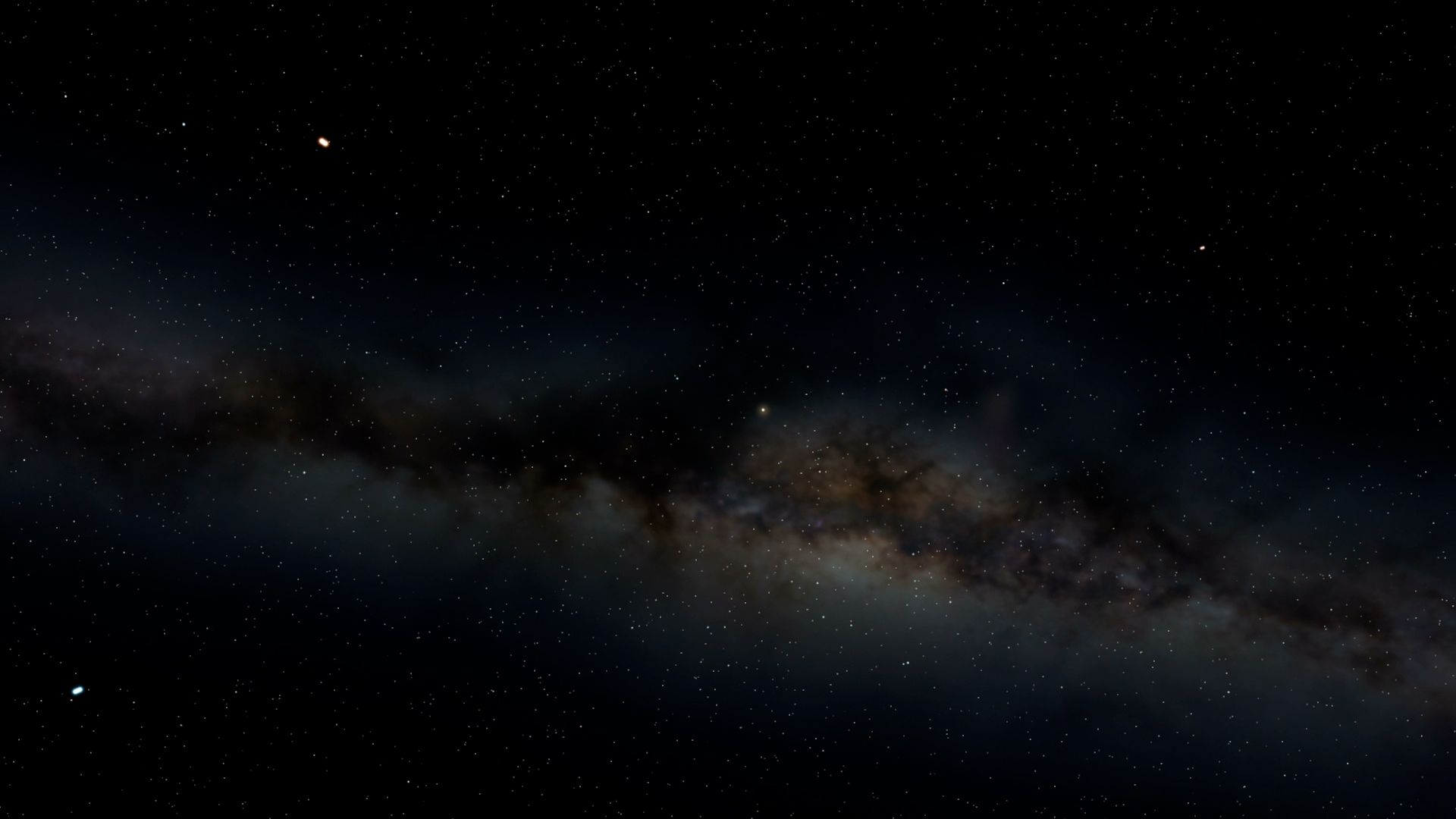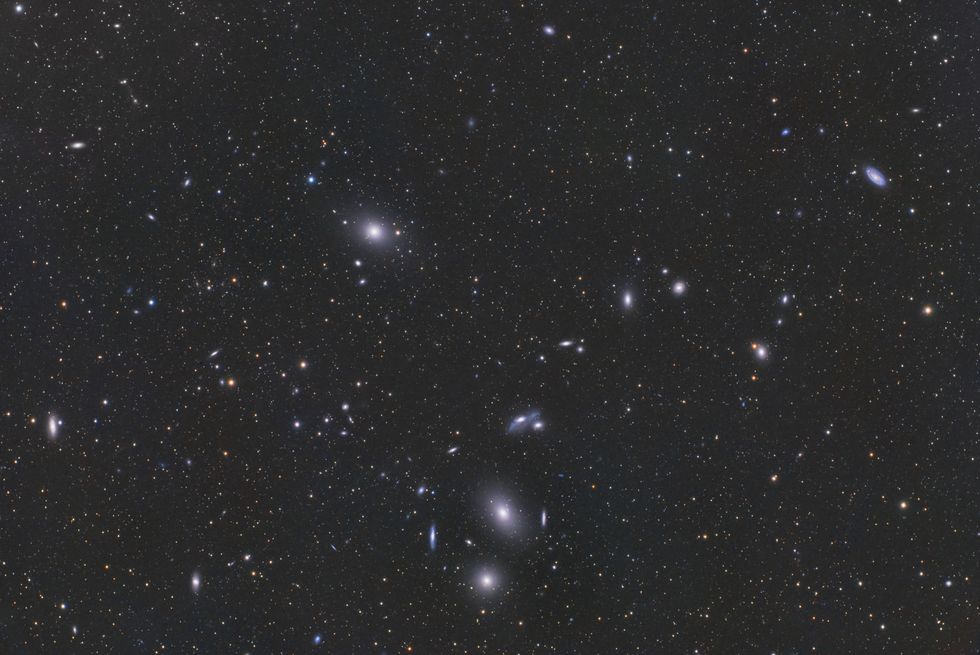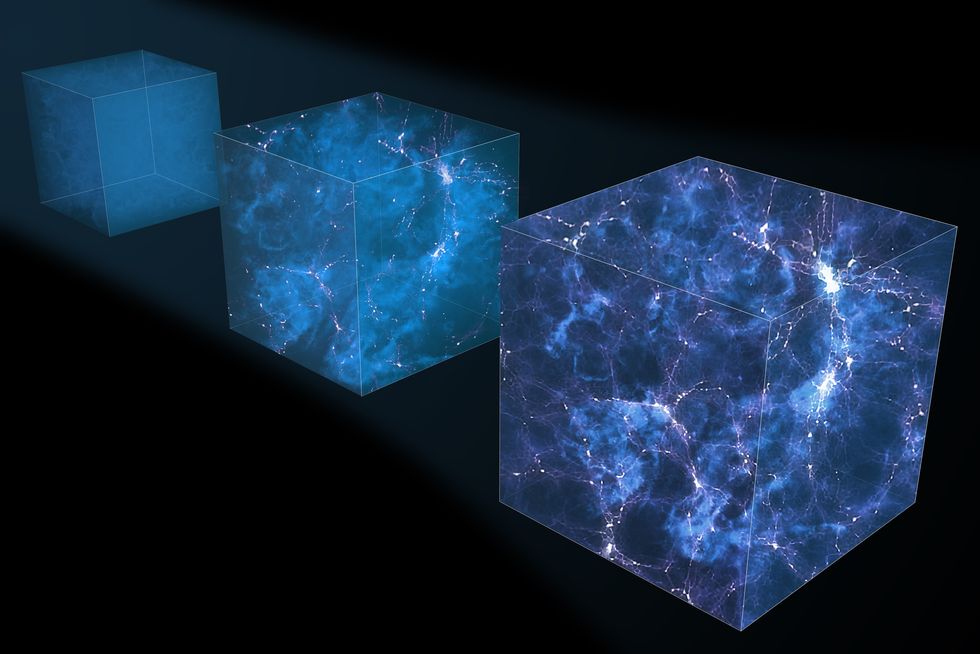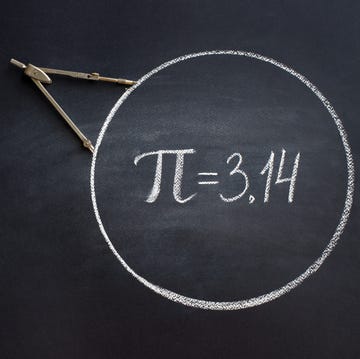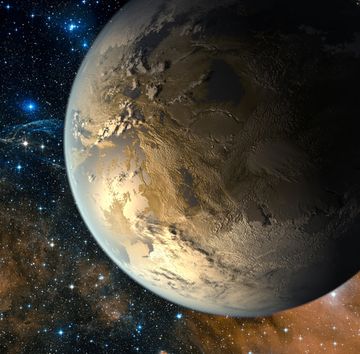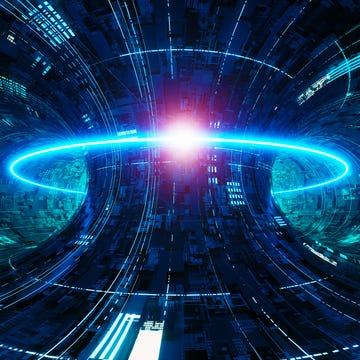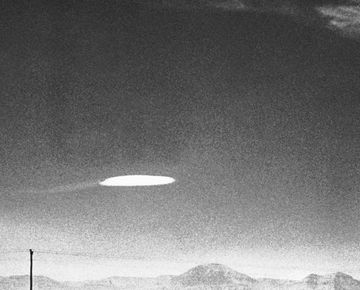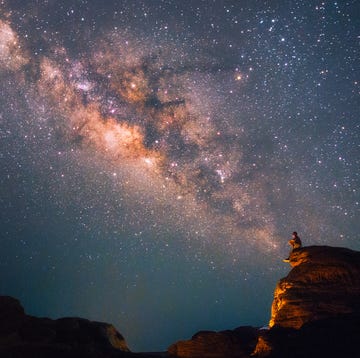There are dark places out there in the deep universe, vast Saharas hundreds of millions of light years across, empty except for a stray hydrogen atom or a bit of radiation. They are the cosmic voids, and they will someday grow to consume the entire universe.
To understand voids, we must first have the proper perspective. And to do that, we need to zoom out beyond the solar system, beyond the Milky Way galaxy, and even beyond all the groups and clusters that comprise our neighborhood of the universe. We need to zoom out so far that entire galaxies—each home to hundreds of millions of stars—become nothing more than tiny dots of light.
At these truly cosmological scales, we see an amazing structure emerge. Galaxies in our universe are not scattered about randomly like salt spilled on the table; instead, they form the largest pattern found in nature. We see dense clusters, home to thousands of galaxies, and long, thin strands connecting those clusters. These strands act like long highways stretching between the clusters, with thousands of galaxies strung along them. And we see those strands bound together to form broad, immense walls.
We call this immensity the “cosmic web.” It’s made of galaxies in much the same way as your body is made of microscopic cells. But that metaphor can only go so far; to make a proper scale model of the cosmic web, your cells would have to be a million times smaller than they are.
But while the lights of the stars and galaxies of the cosmic web stand out, those structures only serve to set the boundaries of the true masters of the cosmos: the empty regions between them. First discovered in the early 1980s, these cosmic voids dominate the volume of the universe. In other words, most of our universe is completely, totally empty.
If you search hard enough you can find small, dim, dwarf galaxies scattered inside the voids, and of course there’s the ever-present thin soup of radiation and particles that flood the cosmos. But the voids are well and truly empty, deserted of any meaningful structure or concentration of matter.
Origin of the Void
The seeds of the voids were planted in the earliest moments of the universe, before even the first stars and galaxies appeared. Billions of years ago, the matter in our universe was almost perfectly uniform, with no variations from place to place. But there were tiny, random, microscopic differences. Just a millionth more matter over here, or a millionth less matter over there.
As our universe aged, those differences grew. Gravity is an incredibly weak force, but it’s very persistent and extremely patient. The regions of our universe with ever so slight an advantage in matter also had a slightly stronger gravitational pull. That caused more matter to be drawn toward that patch, emptying out its surroundings. As more matter accumulated, the gravitational pull grew strong, and the surroundings emptied out even more. Over the course of hundreds of millions of years, the cosmic web began to emerge: first as small clumps, which ignited as the earliest stars; then, small galaxies appeared and merged together before forming the great clusters of galaxies, the filaments, and the walls.
And as the rich got richer, the poor got poorer. The voids started out as small, effervescent dimples in an otherwise smooth and harmonious fabric. But as the cosmic web grew, so did the voids, all their matter rushing into the gravitational embrace of large, bright structures. Today, voids make up over 80 percent of the volume of the universe, yet contain less than a tenth of its total mass.
✅ Cosmic voids are holes in the distribution of matter in the universe, like holes in Swiss cheese or the gaps in a spider web. They are empty of everything, including normal matter and dark matter.
And that emptiness gives them a secret power. In the late 1990s, two teams of astronomers discovered that the expansion of the universe is accelerating; our universe is getting bigger and bigger—faster and faster—with every passing day. We had expected to observe the opposite: in an expanding universe, the gravitational pull of all the matter in the cosmos should gently slow down that expansion, not speed it up. Confirmed with multiple experiments in the past quarter century, the accelerated expansion has a name: we call it dark energy.
Simply put, we have no idea what dark energy is. But we suspect that this mysterious acceleration is somehow a property of the vacuum of spacetime itself. In other words, dark energy is built into the very fabric of the cosmos, and it’s causing the expansion of the universe to accelerate everywhere. But we don’t feel that acceleration locally. Earth is not expanding, the solar system is not expanding, the Milky Way is not expanding, and not even our local cosmological environment is expanding.
That’s because our local patch of the universe is filled with stuff—stars, gas, dust, people. All that stuff has gravitational attraction, and it completely overwhelms the effects of dark energy acceleration.
But not in the voids. The voids are empty. That’s their definition. There are no stars, or gas, or dust, or people. There’s nothing within the voids to counteract the effects of dark energy. And so the voids are growing, accelerating in their expansion. They are literally pushing on the filaments and walls that surround them, driving matter away from themselves in their pursuit of relentless expansion.
The End of the Universe?
In about 10–20 billion years, the cosmic web, with its glory of galaxies, filaments, and walls, will dissolve. First, the filaments will pull themselves apart as the voids around them squeeze them out of existence. Then, the walls will dissolve. The clusters will survive, but each one will become an island universe, effectively alone in a vast expanse of nothingness.
Before that happens, however, we have plenty of work to do. While dark energy soaks every cubic inch of spacetime, it only shows itself in the voids. So if we want to study this mysterious force that will dictate the future of the universe, we can’t look inside the galaxies or clusters. Their internal gravity is just too strong, washing away dark energy’s influence. Instead we have to look into the voids.
The voids are our key to understanding dark energy. Their growth over cosmic time, their shapes, their numbers, and all their properties tell us about the strength and history of dark energy. If dark energy had a different strength or a different evolution, it would show up first in the voids. Astrophysicists have already begun to map as many cosmic voids in the universe as possible to compare their features and characteristics to our theoretical estimations. Researchers hope these wide-region surveys can tease out the subtle and poorly understood properties of dark energy.
But there’s more. The cosmic voids are the greatest time capsules in the cosmos. In billions of years, they simply have not changed all that much. Within galaxies, stars live and die; matter and material drift away and recombine. The galaxies look nothing like their younger selves. But billions of years ago, the voids were simple, empty. And today, billions of years later, they are still simple and empty.
The answers to many cosmological mysteries—the nature of dark energy, the properties of the ancient cosmos, and more—live inside the voids. And so perhaps our greatest insights will only come once we stare into the abyss.
Paul M. Sutter is a science educator and a theoretical cosmologist at the Institute for Advanced Computational Science at Stony Brook University and the author of How to Die in Space: A Journey Through Dangerous Astrophysical Phenomena and Your Place in the Universe: Understanding Our Big, Messy Existence. Sutter is also the host of various science programs, and he’s on social media. Check out his Ask a Spaceman podcast and his YouTube page.
